
The prediction of the evolution of coherent structures in turbulent flows by models linearised over the mean flow leads to a closure problem. We propose to go back to the conservation laws, and to consider a version of the Navier-Stokes equations submitted to a stochastic transport, referred to as « under location uncertainty ». In this framework, the displacement of a particle is caused by a resolved time-differentiable velocity field perturbed by a Brownian motion mimicking the effect of turbulent fluctuations. With these hypotheses, conservation laws show additional terms such as a stochastic diffusion induced by the Brownian motion or an effective transport velocity from high to low turbulence regions.
We propose to linearise this set of stochastic equations over the mean flow of turbulent channels at friction Reynolds numbers 180, 550 and 1000, in order to predict coherent streaks/rolls structures in the buffer and logarithmic layer. We show that for such a flow, it is required to add a non-linear forcing term, as performed in resolvent analysis, to account for non-linear interactions between time-correlated structures, active in the regeneration cycle of roll/streaks structures. We show moreover the improvements of predictions in the logarithmic layer by employing the stochastic modelling.
Bio:
Gilles Tissot est chercheur à INRIA Rennes dans l’équipe Odyssey. Il a effectué sa thèse à l’institut Pprime avec Laurent Cordier et Bernd Noack. Il a effectuer un post-doc à l’ITA (Brésil) avec André Cavalieri, un post-doc à l’institut de mathématiques de Toulouse avec Jean-Pierre Raymond et un post doc au laboratoire d’acoustique de l’université du Mans avec Gwénaël Gaba
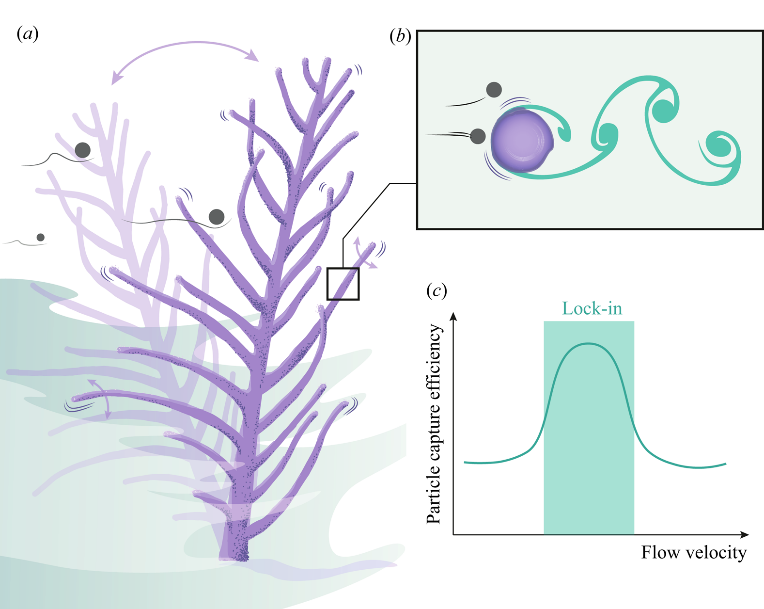
Les coraux mous, tels que le panache marin bipenné Antillogorgia bipinnata, sont des animaux qui forment des colonies et se nourrissent en attrapant les particules de nourriture apportées par les courants. Grâce à leur squelette flexible en forme d’arbre, ils se plient et se balancent d’avant en arrière avec la houle. En plus de ce balancement à basse fréquence de toute la colonie, les branches d’A. bipinnata vibrent à haute fréquence avec une faible amplitude. Nous montrons que les tourbillons lâchés dans le sillage de la colonie corallienne sont probablement responsables de ces vibrations. Pour évaluer l’impact de la dynamique sur l’alimentation par filtration, nous simulons des particules advectées par l’écoulement autour d’un cylindre circulaire et calculons le taux de capture avec un solveur d’interaction fluide-structure. Nous observons que les cylindres vibrants peuvent capturer jusqu’à 40% de particules en plus que les cylindres fixes. Les vibrations induites par les tourbillons (VIV) améliorent vraisemblablement la capture de nourriture par les coraux mous. De même, la dispersion/capture du pollen et la dispersion des graines sont probablement affectées par les VIV.
Frédérick P. Gosselin est un expert en mécanique des structures élancées. Il est professeur au département de génie mécanique de Polytechnique Montréal (en poste depuis 2012). Il a obtenu sa maîtrise en génie de l’Université McGill à Montréal en 2006. Il a ensuite obtenu un doctorat de l’École Polytechnique en France (2009) sous la direction d’Emmanuel de Langre pour ses travaux sur les mécanismes d’interactions fluide-structure entre écoulements et végétation. Il a été professeur agrégé invité au département de botanique de UBC à Vancouver, au Canada, en 2018-19. Il est éditeur associé au Journal of Fluids and Structures. Il étudie une variété de structures élancées allant des branches et feuilles d’arbres, de la soie d’araignée et des membranes cellulaires aux ailes d’avions et turbines hydrauliques. Il est titulaire d’une subvention à la découverte du CRSNG pour étudier la mécanique des structures biologiques élancées.
Pour en savoir plus :
Boudina, M., Gosselin, F.P., Étienne, S. « Vortex-induced vibrations: a soft coral feeding strategy? » Journal of Fluid Mechanics, 2021, 916, A50.

Lors de deux nuits consécutives – le 23 novembre 1725 vers 10 heures et demie du soir et la nuit suivante vers 3 heures du matin – Pierre Bouguer compare la lumière de la pleine Lune à celle de quatre chandelles. Il réalise ainsi la première mesure photométrique documentée et obtenue à l’aide d’une méthode rationnelle. Dans son Essai d’optique sur la gradation de la lumière publié en 1729, le savant a conscience à la fois de l’importance de sa découverte mais aussi du manque d’applications directes de sa méthode. Si la réussite est totale en considérant la pleine lune, les incertitudes de mesures deviennent importantes avec la lumière très intense du soleil. Et Bouguer ne se risque pas à évaluer la très faible intensité des autres astres.
Dans la préface de l’Essai, il envisage une application plus étonnante : la photométrie pourrait servir pour la peinture, plus précisément pour le rendu d’une perspective aérienne, « cette gradation des teintes et demi-teintes, qui est cause que les parties d’un tableau semblent fuir ou avancer ».Cette idée fait écho à la pratique des peintres de la Renaissance, et en particulier de Léonard de Vinci. À cette époque, la perspective et la peinture à l’huile ont permis de traduire les volumes et les reliefs avec un réalisme rarement atteint jusqu’alors. Il n’est donc pas si invraisemenbable que peintres et savants se rejoignent dans la volonté de quantifier des variations de luminosités. Pendant plusieurs siècles, leurs démarches vont se répondre. Mais les liens entre photométrie et peinture se sont révélés plus minces que Bouguer ne l’espérait. En 1857, dans un article intitulé « L’optique et la peinture », le physicien Jules Jamin, s’adressant aux peintres français dits « réalistes », a démontré, photomètre en main, l’impossibilité de conserver sur une toile la même dynamique de luminosités que dans la réalité.
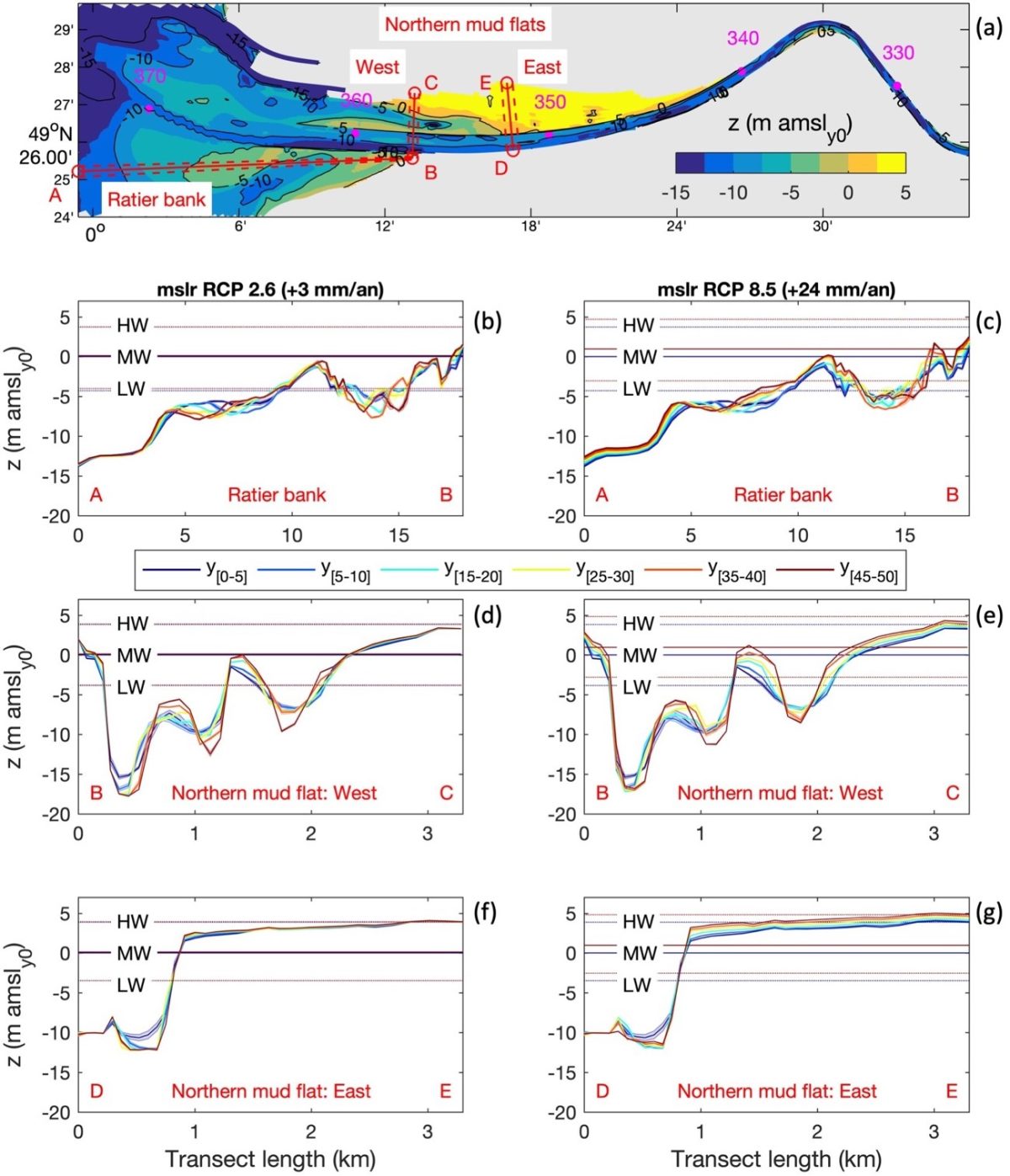
Ce séminaire va porter sur l’évolution hydro-morpho-sédimentaire des estuaires tidaux dans le cadre du changement global. Des modèles numériques ont été déployés sur les estuaires de la Gironde et de la Seine afin d’étudier la réponse de ces systèmes face à différentes conditions hydrométéorologiques (ex. crues-étiages, tempêtes), ainsi que face à des perturbations anthropiques (ex. modifications morphologiques dues aux dragages et aux extensions portuaires). De plus, des simulations morphodynamiques pluri-décennales, réalisées pour différents scénarios de changement climatique ont permis d’étudier la capacité des systèmes estuariens à s’adapter à la montée du niveau de la mer.
Enfin, une démarche inter-estuaires sera présentée, afin d’aller au-delà de notre compréhension site-spécifique et ainsi proposer une conceptualisation globale de la dynamique sédimentaire estuarienne.
Rotating detonation engines (RDE) are currently being investigated to implement pressure-gain combustion thermodynamic cycles. Pressure-gain combustion-based cycle could provide significant improvements over conventional isobaric burners. For practical applications, the knowledge of the heat flux to the wall in such combustor is requirement for the design of any thermal management solution. The flow field in RDE combustors greatly differs from than of conventional combustors and as such yield vastly different heat fluxes distributions in the chamber. Very few experiments have attempted to record both the flow field and the heat flux on such engines. In this work, parametric experiments are conducted on a 100 mm diameter RDE. The engine is operated with mixtures of natural gas/oxygen at mass flow rates ranging 100 to 500 g/s and varying equivalence ratio using two different injector plate design. Calorimetry experiments provided an axial resolution of the heat flux on the outer wall and demonstrated steady state is reached within 2 s in most conditions. A heat sink version of the combustor is also operated with a side optical access. The recording of the channel-integrated chemiluminescence is processed using the velocity-compensated method to provide a time-resolved detonation flow field along the full combustor height. The flow fields obtained are then used to analyse the heat flux distributions obtained.
During the presentation, you will also get to know other projects that are currently being carried out in the Aerospace and Combustion Laboratory at Sophia, like numerical computation of detonation, hypersonic shock tunnel, and drone design.
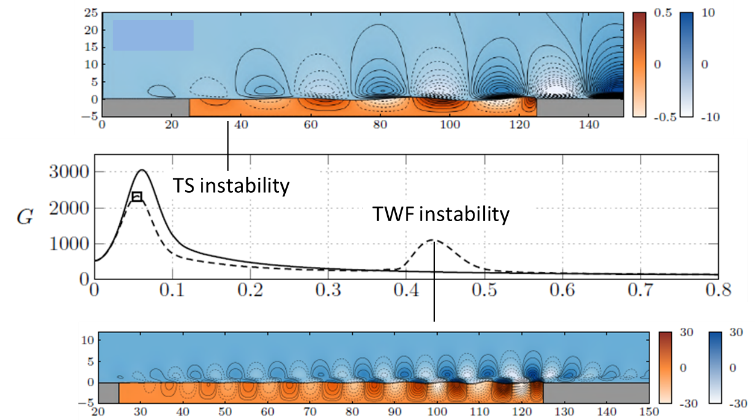
Ce séminaire va illustrer les problèmes d’interaction fluide-structure dont a étudié la dynamique grâce à des analyses linéarisées. Deux approches linéarisées (transpiration et ALE) permettant de traiter la déformation du domaine fluide induite par celle de la structure. Sur un problème jouet, je montrerai les résultats obtenus par ces deux approches et les difficultés numériques rencontrées par l’approche de transpiration qui est la plus naturelle pour un mécanicien des fluides. Dans un second temps, je présenterai des résultats sur la dynamique d’une plaque élastique accrochée à l’arrière d’un cylindre immergé dans un écoulement laminaire à bas nombre de Reynolds. J’illustrerai ainsi l’intérêt et les limites d’une approche de stabilité globale pour comprendre l’apparition des différents régimes observés en faisant varier la rigidité de la plaque.
Pour finir la présentation, je m’intéresserai au problème du contrôle passif des ondes de Tollmien-Schlichting (TS) se développant dans des couches limites sur paroi rigide en introduisant un matériau visco-élastique de longueur finie. En particulier, j’introduirai le formalisme du résolvent aéroélastique permettant d’évaluer l’atténuation des ondes TS à basse-fréquence et d’anticiper l’apparition d’ondes de flottement (TWF) à plus haute fréquence, comme illustré sur la figure ci-jointe.
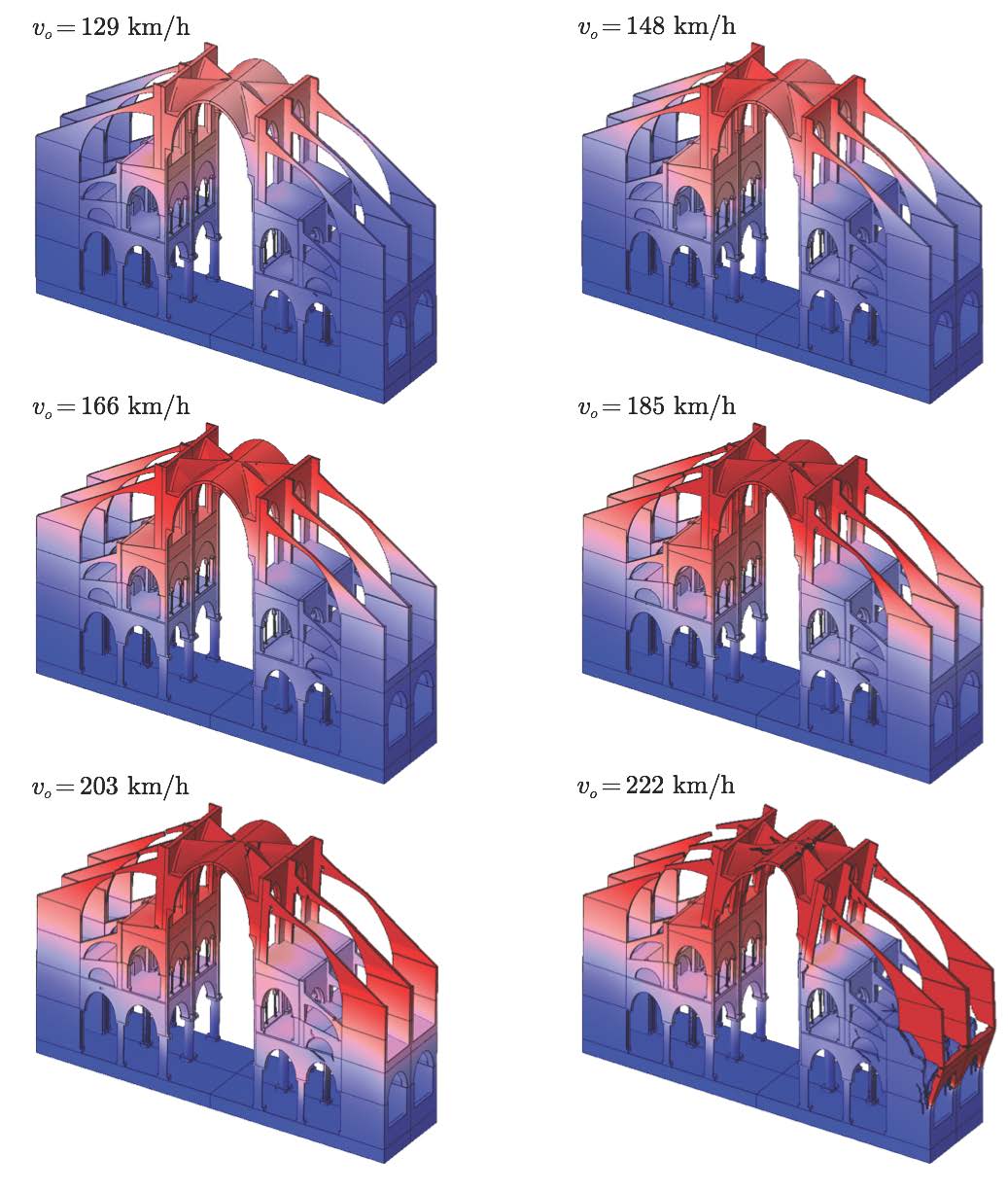
Dans ce séminaire, différentes études concernant la structure de Notre Dame de Paris sont présentées. Ces recherches, lancées bien avant l’incendie du 15 Avril 2019, visent, d’une part, à évaluer le comportement de la cathédrale sous actions extrêmes, notamment tempête de vent et explosions, d’autre part à mieux en comprendre le comportement structural. Ces recherches ont concerné différentes parties structurales de la cathédrale: la structure de la nef, les arcs-boutants, les charpentes détruites par l’incendie. A travers la simulation numérique on a essayé aussi d’apporter une réponse à des questions encore laissées ouvertes par les historiens de l’architecture, notamment en ce qui concerne les transformations faites sur la cathédrale autour de 1220, lorsqu’elle était encore en cours de construction. Une recherche recente, celle-ci à caractère expérimentale, a permis de définir de manière précise l’action du vent sur la cathédrale et l’influence que l’environnement parisien a sur cette action.

Résumé:
Les anneaux tourbillonnaires (AT) sont des structures toroidales de vorticité qui se forment naturellement dans les sillages d’objets ou lors d’éjection de fluide (jet impulsif). Ces tourbillons dominent ainsi la dynamique de nombreux écoulements et sont observés dans des environnements variés. De part leur topologie, les AT ont la propriété de se propager dès lors qu’ils sont créés. Ils transportent alors le fluide qui les compose le long de leur trajectoire. Cela leur confère un pouvoir d’agitation et de mélange dans des zones éloignées de leur lieu de génération. A l’occasion de ce séminaire je présenterai des études que nous avons menées à l’IMFT sur des AT évoluant dans des milieux (i) stratifiés en densité et (ii) rhéofluidifiants viscoélastiques.
(i) De nombreux écoulements sont stratifiés en densité. Par exemple, l’océan et l’atmosphère sont stratifiés en salinité et/ou en température et donc en densité. Lorsqu’un AT pénètre une stratification, les isopycnes se déforment et de la vorticité secondaire barocline est générée. La vorticité primaire, transportée par l’AT, va alors se réorganiser avec la vorticité secondaire. Concernant la dynamique du milieu support, des ondes de gravité sont forcées par l’impact de l’AT et il résulte des interactions fortes entre les ondes générées et la structure tourbillonnaire propagative.

(ii) De nombreux écoulements mettent en jeu des fluides ayant une rhéologie non-newtonienne. On peut citer par exemple le manteau terrestre et la plupart des fluides utilisés dans l’industrie agroalimentaire. Nous nous sommes intéressés à la dynamique singulière d’un AT dans un fluide viscoélastique. En particulier, nous essayons de comprendre les mécanismes menant au « rebond » de la structure tourbillonnaire en milieu infini, i.e., sans présence de paroi solide.
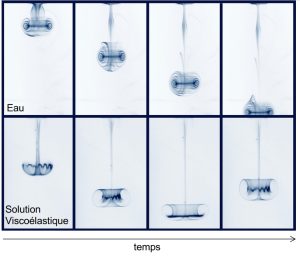

Résumé: Free-surface flows are subdued to hydrodynamic instabilities, one of them observed as a coherent structure propagating at the interface between the viscous fluid flow and air named roll waves. Those instabilities develop from spatial and/or time disturbances, reaching a stationary regime downstream. Then, one important feature to predict the evolution of such a phenomenon is the length required for disturbances to travel before reaching their stationary form. The present work brings a theoretical and numerical analysis of such length required for roll waves to become stationary in a free-surface laminar flow of a Newtonian fluid. Two types of stability analysis are brought to verify flow stability and obtain parameters for wave growth rate in a Saint-Venant-like system. Then, numerical simulations are performed of the free-surface laminar transient flow of glycerin. The Navier-Stokes equations were solved using the finite volumes method, Euler schemes and PIMPLE, and the VoF technique to solve the interface. Boundary conditions were specified to obtain a steady and uniform regime given a Froude number. Then, a sinusoidal perturbation with controllable properties was applied to the inlet velocity. From the numerical results, the spatial development of the roll waves was evaluated, focusing on the establishment length as a function of the Froude number and the perturbation amplitude. The analyses performed allowed the verification of the influence of the flow’s hydraulic regime over the establishment length, and it was possible to obtain a new equation as a function of the perturbation amplitude.










